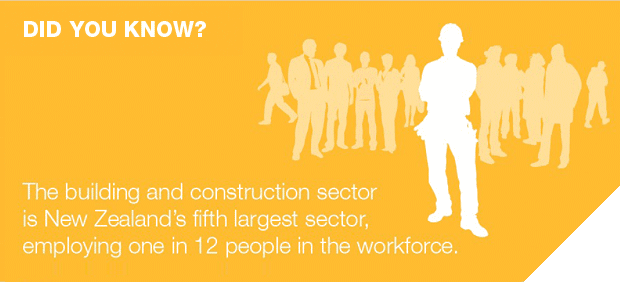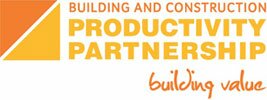|
 VALUE BUILDER – MIKE FOX VALUE BUILDER – MIKE FOX
FOUNDING DIRECTOR OF PRIMESITE HOMES AND CHAIRMAN OF THE REGISTERED MASTER BUILDERS FEDERATION
As an industry participant I am pleased to be able to comment on what the Productivity Partnership means for those at the coal face. Anecdotally, they say the construction industry is slipping behind - not only against other industries in New Zealand - but with comparable countries as well.
So are we a lazy lot that need to work longer and harder on site to produce more? I think not, but we
could do things smarter. The investigatory work being carried out by the Productivity Partnership will supply some answers that, hopefully, will streamline the way buildings are designed, monitored and constructed in New Zealand.
Deserved recognition
The true size and impact that the construction industry has on the overall economy has slipped under the radar for too long and its importance is only now becoming apparent.
Deserved recognition has been helped along by the recent PWC report to the Construction Strategy Group titled "Valuing the role of Construction in the New Zealand economy". Let me share a small excerpt from the PWC report:
"The construction sector plays a large role in the New Zealand economy. It is New Zealand's fifth largest sector employing over 157,000 full-time equivalents (FTEs) or 8% of the total economy. Construction related services employ a further 42,000 FTEs. In the last 10 years, 14% of all new employment has been in the construction sector.
"The sector is characterised by small businesses, and low labour productivity. The 8% of national employment generates only 4% of national GDP, but accounts for 10% of all businesses.
"Output from the sector dominates New Zealand's investment, contributing 44% of all Gross Fixed Capital Formation. The sector plays by far the largest role in building New Zealand's infrastructure stock, which is the foundation of productivity and economic growth."
The jewel in the crown and the overriding fact from the PWC report is that every dollar invested in the construction sector generates a total of three dollars in economic activity.
It is clear that the industry is a big player but, by nature, is fragmented and misunderstood not only by those operating within it but also by those who could utilise its unique set of drivers to assist the overall growth of the economy and the built environment.
It is also an industry that is ravaged by the prevailing economic climate.
The severity of yoyo economic cycles needs to be moderated if we are to have a well-trained and sustainable workforce. The valuable work being done by the Productivity Partnership includes initiatives to help smooth these cycles.
|
The true size and impact that the construction industry has on the overall economy has slipped under the radar for too long and its importance is only now becoming apparent.
|
Pan-industry approach
I am also excited about the research being undertaken by the Productivity Partnership as it is imperative that a pan-industry approach is taken to understanding and gathering evidence to lift productivity.
Matters like how the industry really works, benchmarking the industry accurately against others both here and internationally, the resources the industry needs to create "Built New Zealand", quantifying the negative impact of joint and several liability and the real costs and effects of regulation are all issues that need to be impartially researched before a real difference can be made.
The industry needs to lift its game but meaningful productivity gain is not just about getting people to work smarter and harder on site.
Significant gains could be easily made through the following:
• Better planning
• Less rework
• Forward ordering
• Use of smart technology
• Collaboration of those both on and off site
• A whole-of-life value approach to projects, rather than today's cheapest price
• Standardisation of design and construction.
Furthermore, it requires a fundamental study on what does and doesn't work in relation to design, regulation, procurement type and timing to even out demand, economy of scale, standardisation, best processes, suitable skill sets and whole-of-life value.
This study needs the collaboration of industry best practice and intelligence, backed up with the intellectual grunt and resources of the respective research organisations. No one party will have the answers.
If we really want change to be adopted then it also needs to be relative and packaged along with the tangible benefits that make a difference on site.
The results of this study may mean long-held and entrenched practices may be ditched as the industry and its service providers reinvent themselves into an efficient force to meet the demands of the modern era.
This will require strong industry leadership and a move away from fragmentation and patch protection.
For our industry to prosper I see its future representation becoming more unified and stepping away from operating inisolated silos.
|
For our industry to prosper I see its future representation becoming more unified and stepping away from operating in isolated silos.
|
Low-hanging fruit
I feel there is some low-hanging fruit identified in the Productivity Partnership's Research Action Plan and above. It would seem a shame not to be bold and get some early gains.
Two examples of this as a building practitioner are as follows:
I have noticed a corresponding drop in productivity since the implementation of the Building Act 2004 and the Weathertight Homes Resolution Services Act 2006.
Although well-meaning, they have resulted in the industry becoming so risk averse that the words "discretion, pragmatic, constructive advice and innovation" have been removed from its vocabulary. The last man standing regime is decimating our industry and placing control and significant income into the hands of lawyers and insurers. Words that have now become commonplace are: "I know it is not the best solution or the most productive or economical one for the client, but do it this way because we can't accept any liability".
I am not singling out any party, however, our regulatory control systems have developed significant processes that add little value and knock productivity for six, all in the name of risk protection.
Do you think we can turn the ship back on course?
I believe we can, but it will need some fundamental changes and actually proportioning responsibility to the degree of involvement. This will move us away from the last man standing taking the hit for everyone.
A country with a population no larger than a medium-size international city should easily be able to deliver an efficient, sustainable industry that produces excellent building solutions.
Back to top
|








